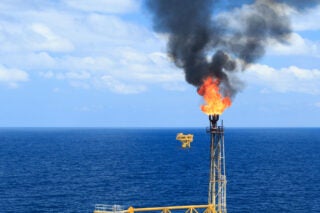- Resources
- How Does Methane Fit into Net Zero Targets?
Resources
How Does Methane Fit into Net Zero Targets?
Published: November 12, 2021 by Guest Author
This piece was co-authored by Dr. Tianyi Sun, Climate Scientist, and Dr. Ilissa Ocko, Senior Climate Scientist, Environmental Defense Fund.
As the international negotiations in Glasgow come to an end, we celebrate getting closer to the goal put forth by the 26th Conference of Parties — securing global net zero greenhouse gas (GHG) emissions by mid-century. While the explosion of net zero pledges over the past year shows tremendous progress, companies and countries must now focus on how to deliver on the commitments they’ve made.
New research from a group of scientists and experts at EDF shows that “Net Zero by 2050” — considered a key indication of ambition — does not guarantee that we achieve the climate benefits we desire. The pathway to get there is also critically important and determines how much warming will occur in both the near- and long-term. The research emphasizes the importance of early action and strategic leadership on both short- and long-lived GHG mitigation to deliver the most favorable climate outcomes over all timescales. Specifically, early action on methane stands out as the most effective strategy to slow warming in the near-term.
Not all net zero paths are created equal
The concept of net zero GHG emissions, made explicit in the Paris Agreement, has been tremendously effective at mobilizing climate action, because it seems simple and straightforward. However, it offers little constraint on the pathway to get there, because of the mid-century timeline.
In this new study, the authors assessed four pathways to net zero with varying mitigation timelines for methane and carbon dioxide (CO2) to illustrate the range of potential climate outcomes. All four pathways achieve net zero GHGs by 2050 but lead to vastly different global temperature outcomes in the near- and long-term.
Early methane action has the largest impact on slowing the rate of warming over the next few decades. When combined with early CO2 mitigation, the impact is maximized. Early action for both can shave 0.4°C (0.7°F) off the peak warming around mid-century when compared to late action for both. This would benefit hundreds of millions of lives across the entire globe, especially in frontline communities.

For CO2, early action is important because it limits the total amount of CO2 put into the atmosphere. But the power of early methane action comes from its potency and short-lived nature as a GHG. Methane has more than 80 times the warming power of CO2 in the first 20 years of its release — but it doesn’t stay in the atmosphere for long, which means reductions in methane emissions can have immediate effects on warming. A recent study shows that deploying all of the technically feasible methane mitigation measures in this decade can slow the rate of warming by as much as 30%.
Methane: The missing piece in the net zero puzzle
The new study warns that it is still possible to temporarily overshoot the 2°C temperature goal even if we achieve net zero by 2050 — which could happen if we fail to act on CO2 and methane this decade. Early action is a critical component of staying below 2°C.
While reducing CO2 emissions as soon as possible has been on the radar of policy makers for decades, the same has not been true for methane because its emissions don’t build up over time like CO2’s. And the standard accounting method used for net zero emissions does not include the benefits of early methane action.
This means that if the only goal is to achieve net zero GHG emissions by a particular year — such as 2050 — then we risk delaying methane action, and losing out on an opportunity to avert many near-term damages.
This is because early methane action can help both communities and ecosystems adapt to a changing climate and hit the brakes on worsening extreme events, like stronger storms and hotter fire seasons. Studies even show that we already have the technologies and strategies to cut methane emissions in half over the next decade, and many of these solutions are affordable and can help reduce the inequity of climate change.
Solution: A two-basket set of interim milestones
An interim milestone before 2050 is important to constrain the pathway and will encourage early action. However, “one-basket” milestones suffer from the same accounting methods used in net zero targets: They undervalue methane’s contribution to warming over timescales of a few decades, because they combine all GHGs into a CO2 equivalent based on their long-term impacts.
Therefore, an ideal strategy to help ensure early action and provide additional nuance, yet still retain the effectiveness and simplicity of the net zero framing, is for companies and countries to supplement net zero targets with a “two-basket” set of interim milestones — for both short- (i.e. methane) and long-lived (i.e. CO2) GHGs separately. In contrast to the one-basket approach, the two-basket interim milestones bring insights that are largely hidden to most companies and policymakers to the forefront, ensures early action for both sets of GHGs, and increases our chance of a better climate outcome over all timescales.
Countries can submit these interim milestones along with their NDCs or net zero pledges to increase the transparency of their mitigation strategies and help determine the near-term climate benefits. Companies can further adapt these milestones according to their unique emission profiles, in order to prioritize and implement company- and industry-specific reduction strategies.
To date, more than 130 countries and 1,500 companies have announced net zero emissions targets. But the path to net zero matters, and different paths lead to different climate outcomes regardless of achieving the net zero GHG by 2050 goal. A two-basket set of interim milestones can considerably strengthen these net zero pledges by enabling a best-case climate outcome over all timescales.
And we are on the right track, because more than 100 nations — that represent about 70% of the world economy — recently signed on to the Global Methane Pledge, committing to 30% methane reductions by 2030. This is the kind of action needed to ensure we tackle both CO2 and methane. It is time for transparent and aggressive implementation to deliver a safer climate for this and future generations.


